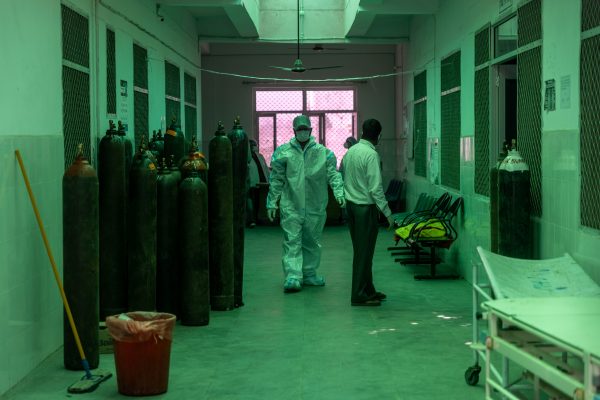India surprisingly turned out to be an outlier in this initial wave. While many Indian states were challenged by a rapid surge in infections, over the first few months India eventually gained an upper hand over the first wave of COVID-19. In 2020, India prevented high fatalities and manufactured critical medical materials such as personal protective equipment and essential drugs in record time and helped supply them all over the world.
But a more infectious second wave hit India’s most populous states — Uttar Pradesh, Maharashtra, Gujarat and Karnataka — in early March 2021. India’s handling of the pandemic became a major embarrassment. The federal government, affected states and healthcare institutions were completely overwhelmed while citizens struggled for hospital beds, oxygen cylinders and essential medicines. It even caused a temporary state collapse.
India’s success in handling its first wave showed that the system can work. The Indian constitution dictates that the handling of health crises, including pandemics, largely falls within the domain of states. Yet given the pan-Indian nature of the threat posed by COVID-19, the central government, with its huge leverage over resources and expertise, assumed the lead and took many key decisions unilaterally. It derived these powers by invoking the Disaster Management Act 2005, which made the Ministry of Home Affairs the lead in a national response.
Still, these powers were not always used effectively. The Ministry issued compulsory guidelines and instructions to the states on matters that ideally should have remained in the states’ jurisdictions. In numerous instances, the central government’s blanket decisions on lockdowns and containment zoning were made without adequate knowledge of the situation on the ground. States were not allowed to purchase medical kits on their own without federal permission.
States had little choice but to grudgingly accept temporary losses of power and autonomy and largely cooperated with the central government. While the government initially centralised pandemic management and assumed many functions of the states, hindering federal spirit, it rolled out timely and critical measures. This included scaling up efforts to plan the production of vaccines domestically, setting standards and guidelines, and ensuring inter-state coordination.
After an initial phase of hyper-centralisation, the national government conceded space to the states in many areas of decision-making, like lockdown measures and containment zoning, which required a localised approach. Proactive federal leadership was eventually compelled towards healthy cooperation with states, which was essential for getting a grip on the first wave.
But the visible success against the first wave made governments complacent. For instance, India’s health minister announced that India was witnessing the ‘dead end’ of the pandemic in early March. Prime Minister Narendra Modi, addressing the World Economic Forum, claimed that India was among few countries to have successfully controlled the pandemic. Despite credible warnings from experts, authorities allowed the major Hindu religious festival Kumbh Mela to proceed, while the central leadership threw itself into election campaigns in five states, holding mass rallies without pandemic-related restrictions.
Many states started experiencing rapid surges in infections and health systems were overwhelmed, triggering panic and public outcry including among the core support base of the ruling party. While the situation demanded a swifter and more unified response from the central government, it pushed for decentralisation. The central government opportunistically passed the blame onto the states, arguing that health is a state issue.
The central government’s decentralisation logic was more visible in India’s COVID-19 vaccination policy. As the country faced acute vaccine shortages, state governments called for autonomy to procure vaccines from international markets. The central government promptly acceded to these demands, even though this was impractical given the stiff global competition for vaccines. Many states found no prospective bidders.
This, along with differential pricing of vaccines, created an ugly blame game between the central government and the states. India lost precious time in its fight against the pandemic and the vaccination drive suffered a severe blow. The central government eventually took back the responsibility on vaccination policy after the High Court stepped in, but the avoidable impasse strained the trust and cooperation that had been built between the two principal stakeholders of federalism during the first wave.
Triumphalism, complacency, politico-bureaucratic lethargy, delayed decisions and an obsessive fixation with assembly polls accelerated the second wave. A lethargic central government struggled to organise disarrayed states and health institutions to mobilise a unified response during a more infectious second wave. The central government’s authority failed as chaos ensued, with states fighting over oxygen and essential medicines until the urgent intervention of the judiciary.
In the first wave, the federal government heeded experts and put up a purposeful response despite India’s weak public health system and low state capacity. Purposeful central–state cooperation helped India navigate the crisis with relatively minimal fatalities.
India’s performance in the second wave should serve as a warning for all federal states: the key to success lies in effective and purposeful federal leadership that can build bridges between the states and a well-coordinated response.
Niranjan Sahoo is Senior Fellow and Ambar Kumar Ghosh is Junior Fellow with the Observer Research Foundation, New Delhi.
An extended version of this article appears in the most recent edition of East Asia Forum Quarterly, ‘Confronting crisis in Japan’, Vol 13, No 3.

